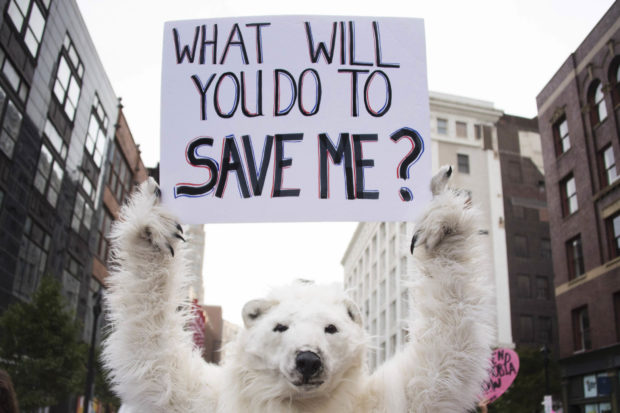
CAMPAIGNING FOR CLIMATE-SAFE PLANET Dressed as a polar bear, a man joins demonstrators against climate change in Cleveland, Ohio, in July 2016. The 197-nation Paris climate treaty, signed in 2015, vows to halt global warming at well under 2 degrees Celsius compared to mid-19th century levels, and pursue efforts to cap the rise at 1.5 degrees C. —AFP
PARIS — Limiting global warming to 2 degrees Celsius will not prevent destructive and deadly climate impacts, as once hoped, dozens of experts concluded in a score of scientific studies released on Monday.
A world that heats up by 2 degrees C — long regarded as the temperature ceiling for a climate-safe planet — could see mass displacement due to rising seas, a drop in per capita income, regional shortages of food and fresh water, and the loss of animal and plant species at an accelerated speed.
Poor and emerging countries of Asia, Africa and Latin America will get hit hardest, according to the studies in the British Royal Society’s Philosophical Transactions A.
“We are detecting large changes in climate impacts for a 2-degree world, and so should take steps to avoid this,” said lead editor Dann Mitchell, an assistant professor at the University of Bristol.
The 197-nation Paris climate treaty, signed in 2015, vows to halt warming at “well under” 2 degrees C compared to mid-19th century levels, and “pursue efforts” to cap the rise at 1.5 degrees C.
Time to adapt
UN Secretary General Antonio Guterres on Thursday said climate change was “the most systemic threat to humankind.”
With only 1 degree of warming so far, Earth has seen a crescendo of droughts, heat waves and storms ramped up by rising seas.
Voluntary national pledges made under the Paris pact to cut carbon dioxide emissions, if fulfilled, would yield a 3-degree world at best.
The treaty also requires that—by the end of the century—humanity stop adding more greenhouse gases to the atmosphere than oceans and forests can absorb, a threshold known as “net zero emissions.”
“How fast we get to a 2-degree world” is critical, Mitchell told Agence France-Presse (AFP).
“If it only takes a couple of decades, we will be in trouble because we won’t have time to adapt to the climate,” he added.
Conclusions in new studies
Researchers led by Felix Pretis, an economist at the University of Oxford, predict that 2 degrees C of global warming will see gross domestic product per person drop, on average, 13 percent by 2100, once costly climate change impacts are factored in.
A 2-degree world will also “show significant negative impact on the rates of economic growth,” Pretis told AFP.
Under a 1.5-degree scenario, he added, growth projections “are near indistinguishable from current conditions.”
Under a 2-degree scenario, oceans rise about half a meter over the course of the 21st century, but well over a meter by 2300, another study found.
“When the planet warms, it takes the ocean hundreds, if not thousands, of years to fully respond,” lead author Robert Nicholls, a professor of coastal engineering at the University of Southampton, told AFP.
That’s bad news for 500 million people living in “highly vulnerable” low-lying deltas, mainly in Asia, along with some 400 million people in coastal cities, many of which are already sinking due overconstruction or collapsing water tables.
Even in a 2-degree world, the number of people affected by flooding could approach 200 million by 2300, the study calculated.
Food, water stress
Two degrees C of warming would spare humanity much misery compared to our current trajectory, but would still lead to increased drought, flooding, heat waves and the disruption of weather patterns.
Some regions will be hit worse than others, as will countries with rainfall-dependent agriculture, a team by Richard Betts, head of climate impacts research at the University of Exeter, found.
The countries that show “the greatest increase in vulnerability to food insecurity when moving from the present-day climate to 2-degree global warming are Oman, India, Bangladesh, Saudi Arabia and Brazil,” Betts told AFP.
A draft “special report” by the UN climate science panel to be unveiled in October, obtained by AFP, concludes that “holding warming at 1.5 degrees C by the end of the 21st century [is] extremely unlikely.”
At current rates, the greenhouse gas emissions putting that goal out of reach will have been released within 10 to 15 years.

